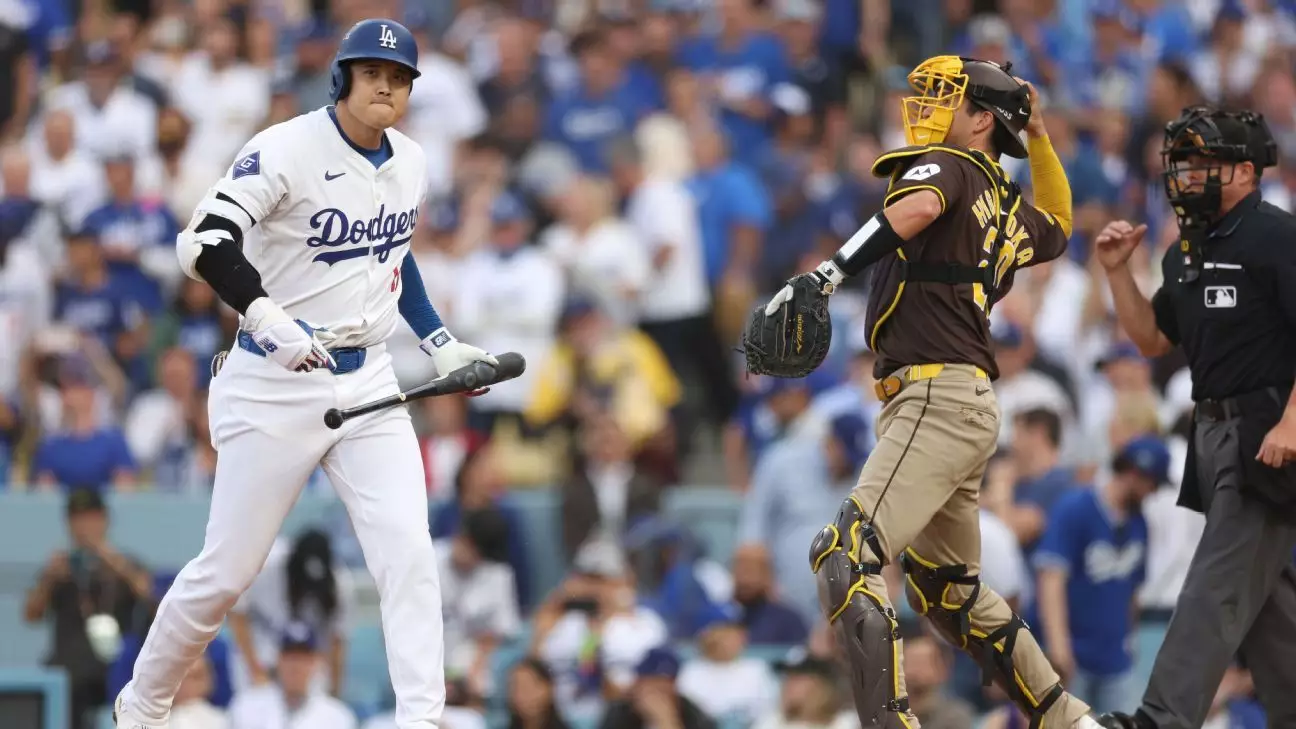As the Los Angeles Dodgers move deeper into the National League Championship Series, discussions surrounding their designated hitter, Shohei Ohtani, have intensified. The dichotomy of his performance this postseason raises eyebrows among fans and analysts alike. Ohtani’s statistics reveal a fascinating trend; he has been significantly more successful when men are on base compared to when he is at bat with the bases empty. Yet, in spite of these stark contrasts in performance, Dodgers’ manager Dave Roberts remains steadfast in keeping Ohtani at the leadoff position. This decision not only reflects the team’s commitment to a particular lineup strategy but also underscores the complexity of baseball’s psychological and statistical dynamics in high-stakes games.
To contextualize Ohtani’s current postseason achievements, one cannot ignore the facts. With no hits in 19 attempts with the bases empty, one might assume that a player of his caliber would warrant a lineup adjustment. Conversely, his striking record of 6-for-8 with runners in scoring positions reveals that he is capable of capitalizing on opportunities. This contrast not only highlights Ohtani’s unique skill set but also elucidates the unpredictable nature of baseball. Roberts’ humorous observation about the evolving narrative surrounding Ohtani’s performance is telling: once seen as a liability with runners in scoring position, he now finds himself in the spotlight, necessitating strategic opportunities for others to get on base before him.
The fact that he still manages a relatively high chase rate further complicates his game dynamics. Ohtani has acknowledged his tendency to chase bad pitches, particularly when facing formidable pitchers, which can reflect a broader pattern of hitters in tense postseason moments. His admission of needing a “reset” when feeling off balance indicates a mindful approach to addressing performance slumps—an aspect crucial for athletes engaged in competitive environments.
Roberts remains unwavering in his belief that Ohtani’s struggles are isolated, attributing them to the unique challenges posed by certain pitchers. His refusal to move Ohtani from the leadoff position stems from a steadfast strategy that has seen him excel in that role throughout the season. Ohtani’s history of batting leadoff, particularly in 90 games this year, reinforces the notion that stability can sometimes outweigh the allure of change. Roberts’ perspective sheds light on the intricate balance between data-driven decisions and psychological factors—understanding when to remain rigid and when to adapt.
Ohtani’s focused approach, emphasizing consistency regardless of the opposing pitcher, showcases his mental fortitude. By acknowledging the randomness that exists in baseball—where luck plays a significant role—he exemplifies a pragmatic mindset, conducive to maximizing potential. This attitude is particularly crucial during the playoffs, where the pressure to perform escalates dramatically.
As the Dodgers prepare for Game 3 against the New York Mets, discussions surrounding player performance inevitably extend beyond individual statistics. The team’s overall strategy hinges not only on the capabilities of star players like Ohtani but also on how well the supporting cast can navigate through a lineup that seeks to exploit pitcher weaknesses. Freddie Freeman’s ongoing ankle injury and its ramifications on lineup stability also illustrate the challenges teams face during the playoff grind.
Ultimately, the decision to maintain Ohtani in the leadoff spot isn’t merely an endorsement of one player; it symbolizes the Dodgers’ commitment to a larger strategic framework. In the high-pressure environment of the postseason, where every game counts, Roberts and his coaching staff lean towards a philosophy that values consistency and player confidence over immediate statistical concerns.
In the coming games, the Dodgers will require Ohtani to exhibit the courage and skill expected of a player of his caliber. The convergence of a player’s mindset and management’s strategic decisions forms a narrative that transcends numbers on a page. As Game 3 unfolds, fans will eagerly await whether Ohtani can find his rhythm amidst the challenges, reinforcing his role as a pivotal player in the Dodgers’ quest for success this postseason. The intricate dance of performance, pressure, and psychological resilience is one of baseball’s greatest narratives, and Ohtani is currently at its center.


Leave a Reply